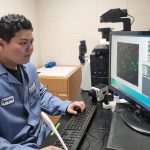Increasing Enantiomer-Selective Production

For some product manufacturers, one of the most important and costliest steps is the chemical-separation process. This is because large resource quantities are needed at the start of the process to yield the desired quantity, and by the end there is a lot of waste. Some manufacturers try to improve this process by manipulating the chemical reaction, which is no easy task. Johns Hopkins researchers may have found an efficient way of controlling those chemical reactions by creating enantiomers using a short DNA sequence catalyst.
Some molecules exist in pairs called enantiomers, which are the same structurally, but mirror images of each other, like a pair of hands. Enantiomers have similar chemical and physical properties, making their separation challenging, but interact differently with substances that have chiral properties. For example, enantiomers can have different effects when used in drugs. This makes them desirable as researchers and manufacturers can choose the enantiomer with the desirable effects they want. However, producing more of the desired enantiomer is challenging.
Efie Kokkoli, INBT core researcher and professor of chemical and biomolecular engineering, and Michael Tsapatsis, INBT core researcher, professor of chemical and biomolecular engineering, and Bloomberg Distinguished Professor, created their catalyst, an artificial metalloenzyme, by using eight DNA base-pairs with just two active nucleotide pairs of guanine and cytosine in the middle of the double stranded DNA sequence. This is a huge feat considering the field initially started with thousands of base pairs and was reduced to 20-30 before Kokkoli and Tsapatsis created the eight base-pair catalyst.
The team also modified their design to accommodate reactions that occur in a mixture of solvents. Previous research only accommodated for reactions in water.
“We demonstrated that if you take the short sequence with only two active nucleotide pairs and turn it into an amphiphile, that the reaction will work in a mixture of water and organic solvent,” said Kokkoli.
The new catalyst can be applied to selectively synthesize enantiomers that can be added in pharmaceuticals, perfumes, and food.
Story from the 2022 Nano-Bio Report. Read the journal article.





